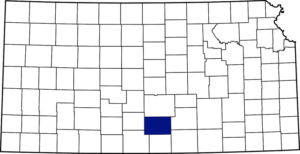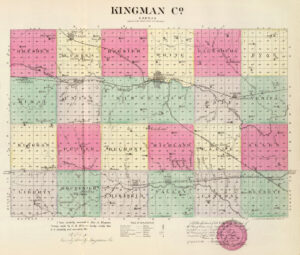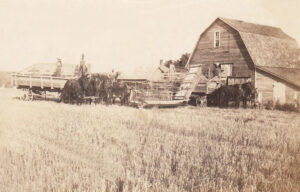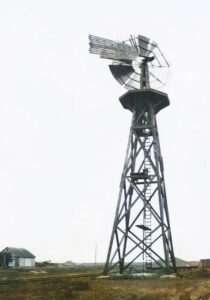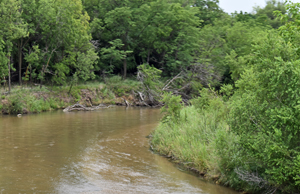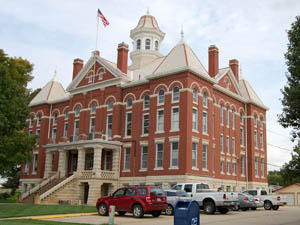Towns & Places:
Cunningham
Kingman (county seat)
Murdock
Nashville
Norwich
Spivey
Zenda
Extinct Towns of Kingman County
Cheney Reservoir
Kingman State Fishing Lake
Arkansas River
Chikaskia River
Ninnescah River
Kingman County, Kansas, is located in the south-central part of the state. Its county seat and largest city is Kingman. The county was named for Samuel Kingman, a Kansas Supreme Court chief justice during the 1860s and 1870s. As of the 2020 census, the county population was 7,470.
The county is located in the second tier from the Oklahoma state line and is bounded on the north by Reno County, on the east by Sedgwick and Sumner, on the south by Harper and Barber, and on the west by Barber and Pratt Counties.
The county’s surface is rolling prairie, somewhat broken near the Ninnescah River. The bottom lands comprised 15% of the total area. Cottonwood is the principal timber and is found along the Chikaskia. The two branches of the Chikaskia River formed an excellent water system. The south branch of the Chikaskia entered the county near the southwest corner and flowed east for 15 miles, where it united with the north branch, forming the main stream, which left the county near the southeast corner. The south fork of the Ninnescah River entered on the west line north of the center, crossed in a southeasterly direction past Kingman, and left the county near the central part of the east line. The north fork crosses the northeast corner. There are several small lakes and springs, and well water is found at a depth of 25 feet. Sandstone, rock salt, gypsum, and mineral paint are abundant.
The first settler is said to have been W.H. Childs, who came from Michigan in 1872. The first settlement was made in February 1873, when Martin Updegraff settled on the Chikaskia River 20 miles south of the present city of Kingman. Half a dozen others settled in the county a few months later, including J.K. and F.S. Fical and Charles Barr. In 1874, W.H. Childs, H.L. Ball, A.D. Culver, H.S. Bush, and W. P. Brown took claims in the Kingman and vicinity. W.H. Mosher settled at the head of Smoot Creek, and several families located on the Ninnescah River. Late in the summer, the settlements were threatened by Indians. Mr. Fical was commissioned as a captain and W.H. Childs asa lieutenant to organize a military company to repel any attack. However, when the commissions arrived, there were no men to organize, and all the residents fled. They returned as soon as the scare was over.
The first farming was done by Charles Barr in 1873. Six years later, 76,000 acres were under cultivation.
A few new people came during the years 1874 and 1876. Many came in 1877, and every part of the county was settled. The last of the buffalo disappeared that year. Heavy spring rains swelled the streams, making them impassable. The settlers were shut off from supplies and threatened with famine. Parched corn was the only food for several days, and even this gave out before the flood subsided.
The county was organized in February 1874, when there were not more than 20 bona fide settlers. Governor Thomas A. Osborne designated Kingman as the temporary county seat and appointed the following officers: J. Harmony, county clerk; and J.K. Fical, J.M. Jordan, and G.W. Lacey, county commissioners. The officers met at Kingman on March 5, and as J.K. Fical withdrew, W.C. Frink was appointed in his place. A special election was called for April 7 to vote on issuing $70,000 in bonds for a courthouse, bridges, and general expenses. It was also ordered that county and township officers be elected and that a permanent county seat be chosen. The election resulted in the choice of the following officers: H.L. Ball, J.K. Fical, and G.W. Lacy, commissioners; J. Harmony, clerk; F.S. Fical, sheriff; J. M. Jordan, treasurer; W.P. Brown, county attorney; George Pitts, probate judge; G.A. Whicher, county superintendent; W. J. Harmony, register of deeds; W.P. Brown, coroner; R.R. Wilson, surveyor; and G.A. Whicher, district clerk. Kingman was made the permanent county seat, and the bonds were authorized. These bonds were printed but were canceled and destroyed the following spring. Two efforts were later made to remove the county seat from Kingman. One was in 1878 when a town called Akron was started in the eastern part of the county. A petition was presented to the commissioners requesting an election to relocate the county seat, and when it was denied, the town of Akron was abandoned. The other attempt was in 1881 when the people in the southeastern part of the county succeeded in having an election called. The competing points were Kingman and Dale City, about seven miles to the southwest. Kingman won by a majority of 85 votes.
Kingman was divided into 23 townships: Allen, Belmont, Bennett, Canton, Chicaskia, Dale, Dresden, Eagle, Eureka, Evan, Galesburg, Hoosier, Kingman, Liberty, Ninnescah, Peters, Richland, Rochester, Rural, Union, Valley, Vinita, and White.
The first school opened in 1874, with only five students and Miss Ada Crane as the teacher.
J.C. Martin established the Mercury, the first newspaper, on June 14, 1878. The paper was small, a five-column folio, and was published by Mr. Martin until August 19, 1880, when he sold the office and material to A.E. Saxey, who changed the paper’s name to the Kingman Blade. Its existence was short, covering only a little over three months, ceasing on December 9, 1880.
Starling Turner built the first water mill in 1879 for $20,000.
The Citizen newspaper was established at Kingman on September 13, 1879, by P.J. Conklin, as sole editor and proprietor, by whom the paper was published until March 1881, when he sold the office and material to George E. Filley, who continued to publish the paper. The Citizen was a six-column, eight-page paper, Republican in politics, and had a circulation of 850.
The 1878 census counted 729 people in Kingman County, but over the next three years, the population increased to 3,125, indicating that the county’s development did not begin until about 1880.
The Republican newspaper was established in Cleveland in July 1881 by Conklin & Childs and appeared first as the Cleveland Star. November 1, 1881, Conklin & Childs sold to Raymond & Myers, who continued to publish it in Cleveland until February 1, 1882, when they moved it to Kingman and changed its name to the Republican. In July 1882, Raymond & Myers sold the paper to E. H. Farnsworth. The Republican was a seven-column, four-page paper, Republican in politics, and had a circulation of about 450.
In 1882, there were 37 organized school districts in the county, and after the school year ended on July 31, 1882, several new districts were organized. There were 38 schoolhouses, of which 32 were frame, five sod, and one stone. At that time, the county school population aged 5-21 was 926, of which 496 were male and 430 were female. The enrollment in the public schools was 772, of which 408 were male, and 364 female, and the average daily attendance was 548. The number of teachers employed was 35, including 13 males and 22 females, and the average salary paid to the former was $ 25.06 per month, and to the latter, $21.15 per month. The number of districts that sustained public schools for three months or longer during the year was 24, and the number failing to sustain a school for three months or longer was 13.
The Kingman County Courthouse was built in 1907-08 in Kingman, Kansas. The three-story rectangular brick building over a raised limestone basement exhibits an architectural character best described as “mixed late Victorian,” blending Romanesque, “Free Classical,” and Queen elements.
In 1910, the county had nearly 150 miles of main-track railroad. A branch of the Atchison, Topeka & Santa Fe crossed the northern part from east to west, another crossed from east to west in the southern part, and another branch of the same system ran through the center from north to south. A branch of the Missouri Pacific Railroad entered in the southeast and extended northwest through Kingman into Reno County. The Kansas City, Mexico & Orient crossed the extreme southeast corner. That year, Kingman County’s population peaked at 13,386.
At that time, the county ranked high in agriculture and stock-raising, with wheat, corn, oats, sorghum, Kafir corn, and hay being the principal crops. The value of the farm products in 1910 was $3,042,500, and its population was 13,386, a gain of about 30% over that of 1900. The property valuation in 1910 was over $30,000,000, making per capita wealth nearly $2,200. There were post offices in Kingman, Adams, Basil, Belmont, Calista, Cleveland, Cunningham, Murdock, Nashville, Norwich, Penalosa, Rago, Spivey, Varner, Waterloo, Willowdale, and Zenda.
The area of Kingman County is 867 square miles or 552,960 acres, of which 863 square miles is land and 3.3 square miles is water.
©Kathy Alexander/Legends of Kansas, updated October 2025.
Also See:
Sources:
Blackmar, Frank W.; Kansas: A Cyclopedia of State History, Vol I; Standard Publishing Company, Chicago, IL 1912.
Cutler, William G; History of Kansas; A. T. Andreas, Chicago, IL, 1883.
Fort Hays State University
Kansas Post Office History
Wikipedia


